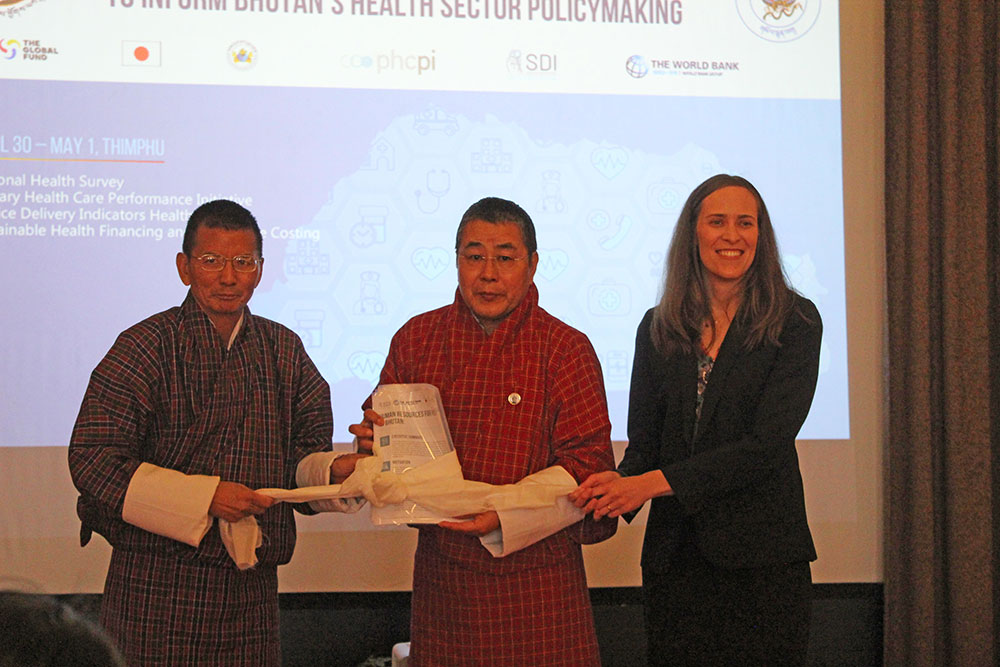Jigmi Wangdi
To enhance the quality of healthcare services in Bhutan, the Service Delivery Indicators (SDI) health survey was conducted from May 2022 to February 2023. The findings from this survey will play a crucial role in developing a well-informed action plan aimed at enhancing the overall health outcomes of the population in the country.
The survey found that most facilities had functional information technology equipment such as telephone (100 percent), printer (94.1 percent), and computer (93.7 percent) available on the day of the survey. However, only 58.5 percent had functional internet, and only 17.3 percent had uninterrupted internet access from March to May 2022.
The survey acts as a crucial instrument for evaluating and comparing the effectiveness of primary healthcare service delivery. It offers policy-relevant data to identify both accomplishments and areas requiring enhancement in delivering health services.
The survey focuses on three domains of primary health care service delivery; foundations, processes of care, and person-centred outcomes. These domains encompass essential aspects such as care organisation, competency of healthcare providers, patient experience, and financial protection.
The survey highlighted observations on primary healthcare foundations, including outpatient volume, availability of pharmacies and laboratory services, and facility connectivity.
Observations in processes of care focused on patient retention, adherence to infection, prevention and control (IPC) protocols, and emergency preparedness.
The survey highlighted patient satisfaction, care uptake and retention, and financial costs incurred by patients.
Health Economist at the World Bank in South Asia, Kathryn Andrews, who led the survey, stated that the success story is around the universal electrification of health facilities.
“However, at the same time, a potential area of growth is around the frequency of power interruptions. Around 10 percent of facilities reported having uninterrupted power over the past three months and a typical facility had about five disruptions of electricity. The median duration of the longest interruption lasts about 12 hours,” Kathryn Andrews said.
She highlighted similar issues in the areas of water availability, internet connectivity and other key areas which could hamper the delivery of services at primary healthcare centres in the country.
It was also highlighted that many facilities had at least one improved functioning and accessible toilet onsite (94.6 percent); a functioning handwashing facility with soap within five metres from the toilet (88.1 percent); and at least one hand hygiene facility at a point of care (86.6 percent).
However, while all facilities had an improved water source, only 39.4 percent reported having an improved, functioning, on-premises water source that was also uninterrupted between March and May 2022.
Recommendations
The survey shared key recommendations to ensure that the delivery of services can be improved upon for effective and efficient quality services.
It suggests strengthening facility accessibility and reducing interruptions to key health facility infrastructure to improve equitable access. It also suggests enhancing service provider capacities through interventions such as refresher training and job aids, especially in areas like maternal and child health and mental health.
Another recommendation is the need to improve management and supervision structures in health facilities by providing management training to facility managers, conducting regular performance reviews, and enhancing external supervisory visits.
The survey also suggests utilising the data from the SDI health survey to inform policy decisions and drive improvements in primary health care service delivery.
It has been found that focusing on person-centred outcomes and ensuring that patients are at the centre of care by addressing patient satisfaction, care uptake, and financial costs incurred by patients will improve the quality of services.
The Bhutan SDI Health Survey is the first of its kind in the South Asia Region, and was conducted through a partnership comprising the World Bank, the Ministry of Health of Bhutan, and the Khesar Gyalpo University of Medical Sciences of Bhutan.


